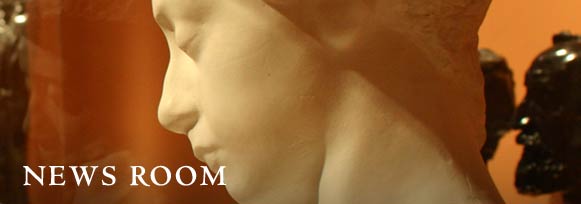Mark Di Suvero Sculpture the Sieve of Eratosthenes Added to Stanford University's Outdoor Art Collection
STANFORD, CA, MARCH 2000—A major contemporary sculpture, The Sieve of Eratosthenes, by artist Mark di Suvero, is the most recent addition to the Stanford University Outdoor Art Collection. It is the gift of New York attorney Daniel Shapiro and his wife, Agnes Gund, and is given in honor of Emeritus Professor John Merryman on the occasion of his 80th birthday. The Sieve of Eratosthenes, which is made of steel and is 23 feet tall, is sited on the north side of the Cantor Arts Center near the conjunction of Lomita Drive and Campus Drive.
Mark di Suvero was born in Shanghai in 1933. He later settled in northern California with his family, and studied art and philosophy at the University of California at Berkeley, where he received his B.A. in 1956. Di Suvero then moved to New York, and by the early 1960s he was recognized by critics as an innovative sculptor who developed a signature style that employed large-scale steel beams and wood. Although the works were massive, they were also approachable because of the ledges, swings, and other kinetic elements that invited play and public participation.
Di Suvero's work is linked to art historical movements such as Cubism, Constructivism, and Minimalism, with their emphasis on geometry and structure, as well as to Abstract Expressionism and Surrealism, with their interest in gesture. As art historian Barbara Rose commented, "Di Suvero is able to synthesize the divergent tributaries of mainstream modernism—including the engineered movement of kinetic art and the spontaneity of Surrealist drawing in the air. His genius lies in his unique ability to fuse the excitement of the momentary—expressed in the potential for imminent change of the swinging, twirling, and precariously poised elements—with the gravity of a timeless geometry and the engineered stability and intuitive equilibrium that his hard-won mastery of structural balance makes possible."
Fabricated in 1999, The Sieve of Eratosthenes is typical of di Suvero's sculptures in providing multiple readings and viewpoints as the spectator walks around it. The title reflects di Suvero's interest in philosophy and humanistic concerns. It is named in honor of the Greek philosopher, geographer, and mathematician Eratosthenes (c. 275-194 B.C.), among whose achievements was the calculation of the circumference of the earth.
According to the donors Daniel Shapiro and Agnes Gund, the dedication of The Sieve of Eratosthenes in honor of Emeritus Professor John Merryman is especially appropriate. Shapiro has praised Merryman's contributions to art and cultural property law, and to scholarship and teaching. The donors wish to honor Merryman "by thanking him for all he has done for us and everyone interested in art by giving a gift in his honor to Stanford of a work of an artist that John thought was sorely missing on campus. And so now, because of John, there is Mark di Suvero's The Sieve of Eratosthenes, the work of a great artist to celebrate a great teacher and friend of art."
The Sieve of Eratosthenes joins some 50 other sculptures that are part of the Stanford University Outdoor Art Collection. Outdoor Sculpture Walk Tours take place (rain or shine) the first Sunday of each month at 2 pm. Visitors meet at the Main Quad of the university. The tours are free and do not require reservations for groups of ten or fewer. For more information about Outdoor Sculpture Walk Tours or any of the docent tours offered by the Cantor Arts Center at Stanford University, call the Educational Services Office at 650-723-3469.



